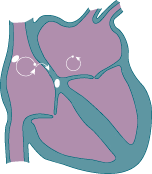










|
|
A
Guide to Arrhythmias

What
is an Arrhythmia?
How are Arrhythmias
Diagnosed?
How are
Arrhythmias Treated?
The Normal Heart
The
Premature Heartbeat
Abnormal Heart
Rhythms
What
is an Arrhythmia?
An abnormal
heart rhythm is a change in either the speed or the pattern of the
heartbeat -- the heart may beat too slowly, too rapidly or irregularly.
A heart which beats too fast or too slow can cause:
·
Lightheadedness or dizziness
· Palpitations (skipping,
fluttering or pounding in the chest)
· Fatigue
·
Chest pressure or pain
· Shortness of breath
·
Fainting spells
Sometimes there are no symptoms at all. Left
untreated, certain abnormal heart rhythms can cause death. On the other
hand, some arrhythmias are common and not associated with any untoward
conditions, so called benign arrhythmias. One of the goals of evaluation
is to sort out the serious from the benign forms of heart beat
disturbances.
How
Are Arrhythmias Diagnosed?
If
your doctor suspects that you may have an arrhythmia, he or she will
order one or more of the following diagnostic tests to determine the
source of your symptoms.
Electrocardiogram
The electrocardiogram (ECG) records the heart's electrical
activity. Small patches called electrodes are placed on your chest, arms
and legs, and are connected by wires to the ECG machine. Your heart's
electrical impulses are translated into a wavy line on a strip of moving
paper, enabling doctors to determine the pattern of electrical current
flow in the heart, diagnose arrhythmias and heart damage.
Holter
Monitor
The Holter monitor is a small,
portable machine you wear that makes a 24-hour continuous recording of
electrical impulses as you go through your normal daily activities. The
machine detects arrhythmias which may not show up in an ECG. You will be
asked to maintain a diary of your activities and symptoms while wearing
the monitor.
Exercise
Stress Test
The exercise stress (treadmill)
test enables physicians to record your heart's electrical activity which
may not occur at rest.
Event
Recorder
The event recorder (transtelephonic
monitoring) is a tape recorder and disk worn over a period of time. When
you feel an arrhythmia, you telephone a monitoring station so a record
of the episode can be made. The monitor also has a memory you can
activate if a phone is unavailable.
Tilt
Table Test
Tilt table testing is used to
diagnose vasovagal syncope (fainting or black-out spells) by trying to
reproduce the black-out episodes. You will be tilted upright to about 60
degrees on a special table for a period of time with continuous
recording of your ECG and blood pressure.
The
Electrophysiology Study
The EP study allows
doctors to:
- provoke and examine an arrhythmia under
controlled conditions;
- acquire more accurate, detailed information
than with any other diagnostic test;
- choose the most effective treatment for you;
- in many cases, provide treatment (i.e.
catheter ablation) during the same session.
During the study, doctors insert special
electrode catheters -- long, flexible wires -- into veins and guide them
into the heart. These catheters sense electrical impulses and may also
be used to stimulate different areas of the heart. Doctors can then
locate the sites which are causing serious arrhythmias.
The
Normal Heart
 The
heart is muscular and hollow, constantly pumping blood to deliver
oxygen and nutrients to the body. It is comprised of four
compartments, or chambers- two on the right side and two on the left.
The upper chamber on each side, called the atrium (plural:
atria), receives and collects blood. The lower chambers- the
ventricles-pump blood. All four chambers work together to move
life-sustaining blood through the body. The
heart is muscular and hollow, constantly pumping blood to deliver
oxygen and nutrients to the body. It is comprised of four
compartments, or chambers- two on the right side and two on the left.
The upper chamber on each side, called the atrium (plural:
atria), receives and collects blood. The lower chambers- the
ventricles-pump blood. All four chambers work together to move
life-sustaining blood through the body.
The heart's rhythmic
contractions depend on an electrical system which conducts electrical
impulses throughout the heart. The sino-atrial (SA) node (see
illustration) is where the electrical impulse normally begins, setting
the pace for the heartbeat. The impulse spreads through the atria,
causing a contraction and squeezing blood into the ventricles. From
the atria, the impulse reaches the atrioventricular (AV) node-a
site where each electrical impulse slows down before it passes through
to the ventricles. Normally, except at the AV node, the atrium is
electrically insulated from the ventricle by fibrous tissue. Through a
specialized muscle fiber system, the impulse is distributed throughout
both ventricles, causing them to contract and pump blood.

This normal conduction is called normal
sinus rhythm- the rhythm is regular and the heart beats 60 to 100
times per minute.
The
Premature Heartbeat
A
premature heartbeat comes too soon and interrupts the regular rhythm
of the heart. Premature beats may originate in the atrium (premature
atrial contraction or PAC) or in the ventricles (premature ventricular
contraction or PVC), producing a sensation that your heart is "skipping"
or "flip-flopping." Although premature beats are more common
in people with heart disease, almost everyone has experienced a "skipped"
beat once in a while, which may be due to smoking, fatigue, alcohol,
caffeine, other stimulants, or may have no apparent cause. Usually
single premature beats require no treatment. However, when they are
frequent or annoying, your doctor may recommend a test to search for
their cause.
Abnormal
Heart Rhythms
Click on
one of the abnormal rhythms below to see their mechanism:
Atrial
Flutter
AV
Nodal Reentry Tachycardia
WPW: Wolff-Parkinson-White syndrome
Bypass tract tachycardia
Atrial fibrillation
Ventricular tachycardia
Complete heart block
More information on EPS and ablation
Mechanisms of tachycardias
Atrial flutter
 
AV nodal reentrant tachycardia

Wolff-Parkinson-White syndrome:
Sinus rhythm


AV bypass tract tachycardia
Atrial fibrillation
Complete heart block
Ventricular tachycardia
Courtesy of Michael Lesh, UCSF
|

